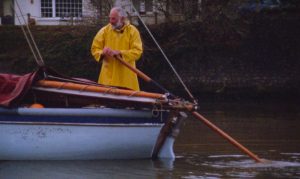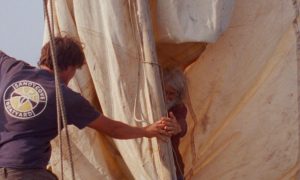Engineless sailors have a multitude of skills and techniques at their disposal that help them safely manoeuvre and navigate a vessel on the water. Many of these practices involve traditional tools that are no longer commonplace on sailing boats, while others use conventional kit in traditional ways. Innovation and resourcefulness are necessary characteristics of a good engineless mariner, and thus the list of engineless sailing techniques is likely endless.
Wind, Tide & Oar does not focus on the technical aspects of sailing engineless, but rather the feel and experience of doing so. For this reason, many methods that belong to engineless sailing do not feature in the film. That said, there are a few distinctive moments that showcase traditional seafaring skills. Below is a brief description of some of these moments.
Warping

Warping is a critical piece of the engineless seafarer’s repertoire. It refers to the process of moving a boat by hauling on lines (ropes) that are attached to the shore. It is used, for example, to manoeuvre a boat in and out of tight berths, into different berths that have better conditions for leaving under sail, or altering a boats positioning to make the wind direction more advantageous. It might also be used to help moor a boat; if it is unrealistic to sail alongside, an engineless boat could anchor nearby, throw or row lines to shore and pull itself into place. Pulling a particular line at the right moment can also give a forward momentum, allowing the boat to get going in light airs, making it easier to sail off a berth. There are numerous applications for warping, not all of which are covered here.
In the film, we see Rose and two friends warping Defiance out of her finger berth. The wind direction was straight into the channel between the berths, and it was quite challenging to get Defiance out. Though the film doesn’t show it, there were numerous attempts. In the end they were successful and managed to manoeuvre Defiance out into the river, enough to achieve a good angle on the wind so she could sail off.
Leadline

Most coastal areas are tidal, meaning the height of water in any given place is always either rising or falling. It is important for any sailor to know the depth of water beneath the boat when navigating coastal areas, and particularly when mooring or unmooring. This is particularly critical for the engineless sailor: manoeuvring a vessel under sail requires space, whereas motoring propels the boat in one linear direction. An engineless sailor must have an idea of how much space there is, i.e. how far a boat can safely go while still having enough water underneath her keel.
In modern times, boats are fitted with depth sounders. These impressive instruments use echo sounding to calculate how much water there is beneath the boat. They provide the figure on a screen, usually located in the cockpit, and continually update as the boat moves. Traditionally, however, the depth was ascertained manually by using a leadline. This simple piece of kit has been used, unchanged, for thousands of years. It consists of a piece of lead tied to a line or rope, which is knotted along its length at intervals of a chosen measurement (feet, metres or fathoms). When the boat is under way, the lead is thrown forward, with the line allowed to run through ones hands. When the lead hits the bottom, the thrower feels it do so, and uses the knots on the line to ascertain the depth of water. In the film, we see Stevie on his boat Birubi throw the lead in this way.
We also see Rose drop the lead straight down into the water. The boat is anchored while she does this, so she doesn’t need to throw the lead forward to counteract the boat’s forward movement. She is checking the depth of water before she gets the boat underway so that she has an idea of the height of tide, and how much space she is likely to have around the boat.
Rowing

It can be surprising to learn that even a large boat can be effectively rowed. All the engineless boats in the film can be, and often are, rowed, using oars (or sweeps) appropriate for the size of the vessel. The 90-foot Thames sailing barge Blue Mermaid, for instance, has two very long sweeps that can row her at the rate of one knot when necessary. It is a lot of work, and requires at least two people, but it is possible.
We see several instances of rowing in the film. The Looe lugger Guide Me has both a sculling oar (an oar off the stern of the boat) and two sweeps for rowing. In the film she is becalmed in the English Channel and the crew begin to row. As long as there is not much wind, and not much contrary tide, a large boat can be rowed very effectively (albeit slowly). As Jonathon, the skipper of fishing boat Katrina, says: ‘I would leave the mooring without an engine, but I’d never leave the mooring without a sweep’.
Dipping Lugger

This is not strictly an engineless sailing technique, but a peculiarity of a certain kind of sailing rig, namely a dipping lug. Guide Me, featured in the film, is a Looe lugger and has a dipping lug forelug (the big sail on the forward mast).
The dipping lug receives its name from the fact that every time the boat needs to tack or gybe (put the bow or stern of the boat through the wind), the sail and its heavy lug (the spar that the sail is attached to) must be lowered down to deck, changed sides, and hoisted again on the new tack. This is very labour intensive compared to other sailing rigs, and makes luggers hard work to sail. We see this procedure in the film, which Huw shot in slow motion onboard Guide Me. The sail comes down, along with the lug, which the skipper Jonno receives and moves around the front of the mast to the other side of the boat, before the sail is rehoisted.
All images courtesy Huw Wahl